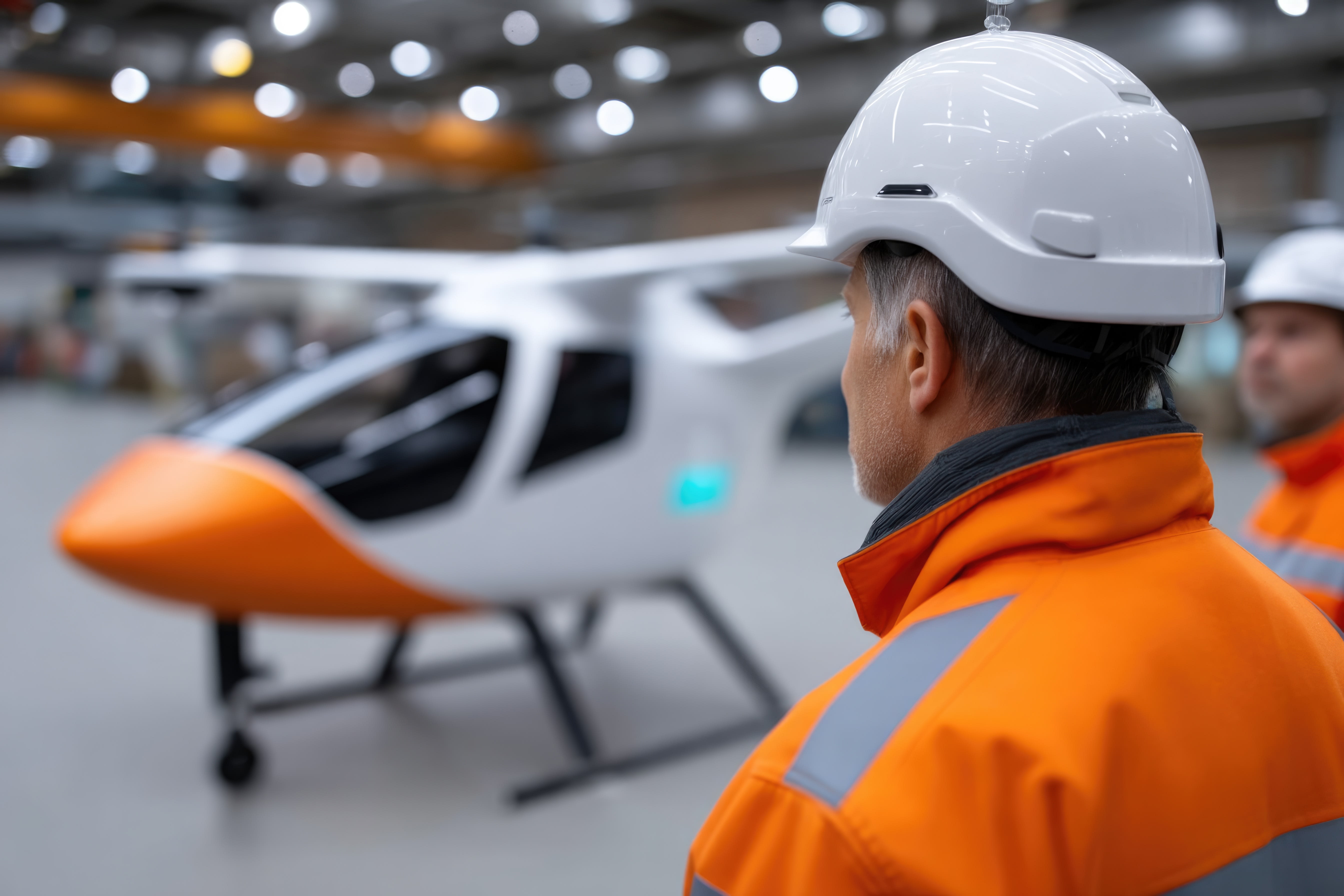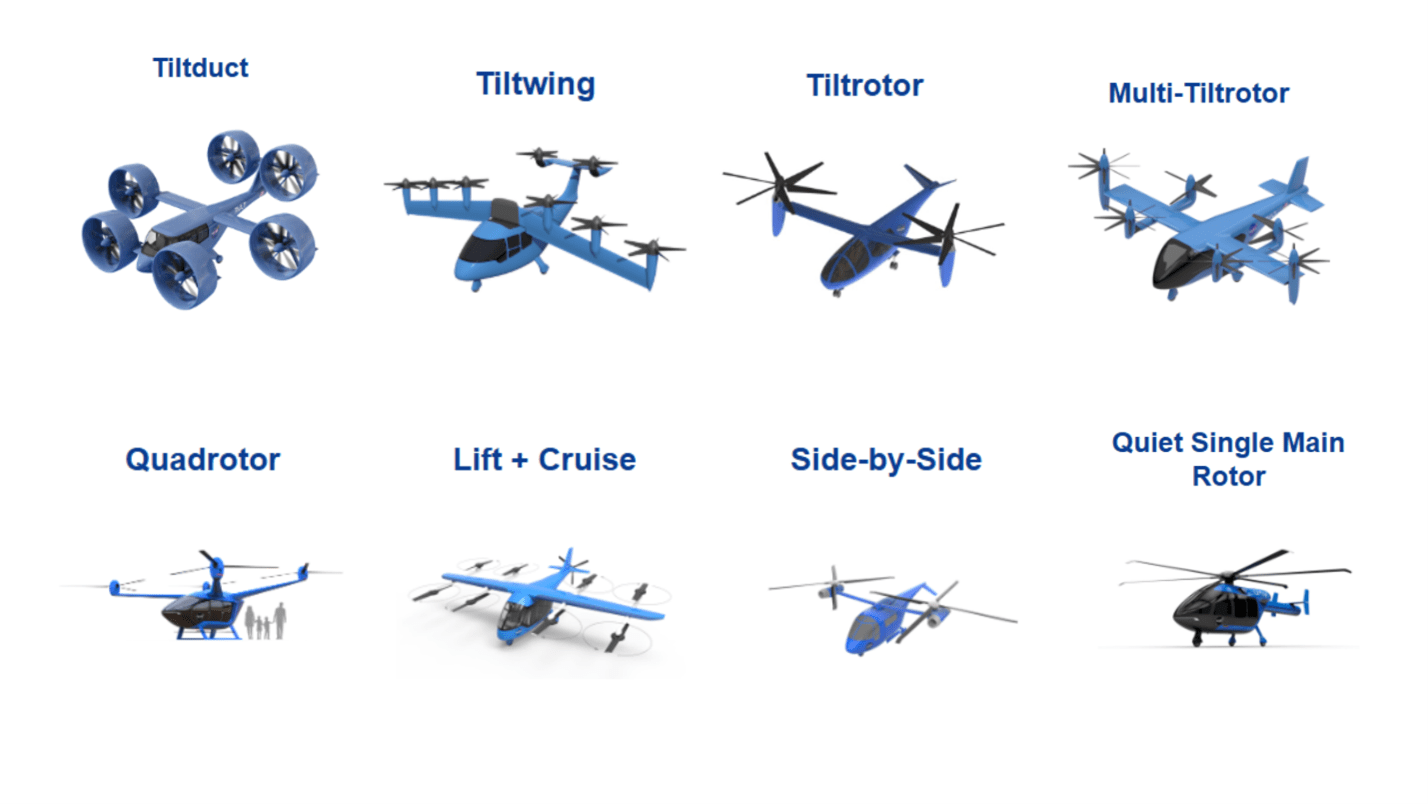Uncovering the Engineering Tech of Urban Air Mobility

Source: Larisa/stock.adobe.com; generated with AI
Early urban air mobility (UAM) prototypes have taken many different forms. In addition to the typical size, weight, and power (SWaP) considerations for aerial vehicles, UAM designs must account for factors such as noise, cost, vehicle range, and passenger comfort.
These engineering considerations quite literally shape the vehicle. For example, a UAM designed for longer flights may have forward-tilting propellers and wings. In contrast, one designed for short intra-city trips may feature multiple fixed propellers optimized for vertical lift.
This article examines the key components that go into designing a UAM, including battery density, propulsion, safety, and turnaround time. It also explores how an aircraft’s use case influences its final architecture, highlighting examples such as air taxis, emergency response aircraft, and cargo delivery.
Balancing for SWaP
Most UAM vehicles are electric vertical takeoff and landing (eVTOL) aircraft, relying on high-density batteries for power. Some designs employ hybrid systems that add fuel cells or a traditional combustion engine for high-performance capabilities. In either case, pure electric operation is preferred during the most demanding flight regimes like takeoff and landing because electric motors offer high instantaneous power. 1 Additionally, urban populations are likely more willing to accept the lower noise and emissions associated with electric motors.
While batteries make UAMs a better choice for dense urban environments, they also come with constraints on energy capacity. That's why the energy architecture of a UAM impacts a wide range of design choices:
• A battery's mass and the efficiency of its powertrain directly influence its maximum takeoff mass, range, and payload.
• Battery pack size and distribution may require engineers to reshape the aircraft’s fuselage, reposition components, and reinforce specific segments.
• Battery placement impacts a vehicle’s center of gravity, which in turn affects flight characteristics, including engine placement and shape.
• Some eVTOLs may require complex thermal-management systems with dedicated cooling ducts, piping, or heat exchangers.
• Redundant systems and engines improve safety but also increase mass and reduce energy efficiency.
• Hybrid UAMs that augment their batteries with combustion engines offer a greater operating range and can support heavier payloads at the cost of a larger, more complex footprint.
Ensuring Optimal Range
These challenges and engineering tradeoffs are evident in the US National Aeronautics and Space Administration (NASA) list of UAM reference vehicles (Figure 1). 2 These eight design concepts represent a wide range of use cases, and the vehicle configurations are similarly diverse, ranging from traditional helicopter-style designs to familiar quadrotor layouts and more radical concepts with wings and a multitude of tilting propellers.
 Figure 1: NASA UAM reference vehicle lineup. (Source: NASA)
Figure 1: NASA UAM reference vehicle lineup. (Source: NASA)
Range is a key consideration behind all these concepts. In fact, range is one of the core design drivers for all UAMs, informing battery size selection, architecture, and propulsion systems. In the case of the NASA UAM reference vehicles, most are designed for short-range, intra-urban missions, which are roughly 75 nautical miles with a 20-minute cruise reserve.
This is generally considered the baseline for most intra-city and suburban UAM flights. NASA's UAM designs reflect the needs of short urban flights, with lightweight structures and distributed electric propulsion to make vertical lift and hovering more efficient. These choices help cut energy use during takeoffs and landings, which is something that happens often in city-based operations.
NASA’s tandem-rotor and tiltwing concepts are notable exceptions. Both are designed for longer missions, incorporating wings and tiltrotors for cruise efficiency. They also use different propulsion systems: hybrid and turbo-electric, respectively.
Reducing Propulsion Noise
As previously noted, noise is another critical concern. Most people who live in urban environments are subject to the occasional low-altitude aircraft. At the same time, the noise produced by even a single helicopter can be both distracting and disruptive. Multiply and amplify the noise created by a single aircraft by the number of UAMs that could take to future skies, and one may understand why noise reduction is so crucial to UAM design.
UAMs will operate much closer to population centers and at much higher densities than traditional aircraft. If these vehicles are not significantly quieter than helicopters, they won’t be accepted by the community. At best, people may simply refuse to use them; at worst, they may actively protest the installation of vertiports and other UAM-related infrastructure.3
The central design considerations regarding noise reduction are related to rotor aerodynamics. Larger rotors with a slower rotational rate reduce noise by lowering blade tip velocity. At the same time, they increase a vehicle’s physical footprint. Additionally, rotor size is limited by structural constraints, aerodynamic inefficiencies at larger diameters, and the need to fit within tight urban landing zones.
Multi-rotor configurations can reduce a vehicle’s noise emissions. Unfortunately, each additional rotor increases a UAM’s mass and may reduce its power efficiency. Similarly, while a propeller with more blades is quieter, each additional blade may complicate both manufacturing and vehicle structure. Blade shape also plays an important role. Thin, tapered blades tend to be quieter but have aerodynamic and structural limitations.
The way a UAM is flown also impacts its noise signature. Some maneuvers produce more noise than others. While this doesn't directly influence vehicle design, it may play a role in the development and layout of supporting infrastructure like vertiports.4
Ensuring Safety Through Redundancy and Reliability
As with any aircraft, safety is a non-negotiable requirement for UAM design. Urban aircraft, particularly those that carry passengers, must demonstrate a high level of reliability. This is most commonly achieved through the use of multiple redundant systems, including rotors, powertrains, flight control systems, and batteries or fuel tanks.
Engineers must design vehicle architecture in such a way that the loss of one system does not result in failure. Balancing this requirement with the vehicle’s SWaP is not the only challenge they face: They must also account for evolving certification standards and requirements. This typically means including not just baseline fail-safe operations and emergency landing capabilities, but also incorporating advanced fault detection and isolation, additional battery safety measures, and more robust architecture.5
Prioritizing Passenger Comfort
Air taxis cannot be designed solely for functionality. Engineers must also incorporate ergonomics. A passenger UAM must therefore be designed with comfort, visibility, and accessibility in mind.6
This is most commonly reflected in the aircraft's cabin. Passenger UAMs generally feature large side and forward-facing windows to provide passengers with full visibility of their surroundings during their flight. The cabins also accommodate a wide range of body sizes and physical limitations, with storage for luggage and items such as wheelchairs.
Comfortable seating and a great view aren't the only things that contribute to a decent flight. Designers must also consider how to control cabin pressure, temperature, humidity, and lighting. And just as exterior noise reduction is essential for community acceptance, reducing interior noise and vibration is equally crucial for passenger comfort.
NASA has even gone so far as to regard vibration and noise sensitivity as primary design considerations, even more important in UAMs than in other passenger aircraft.7 To dampen noise and reduce vibrations, UAMs may incorporate lightweight composite materials, structural damping, rubber isolation of vibrating parts, or acoustic insulation.
Traditional noise-reduction methods don't work as well for low-frequency sound and, in many cases, don't align with the constraints of UAM designs. Therefore, some engineers are seeking alternatives like active noise control and smart actuators to address the problems more effectively.8
Lastly, passengers require easy embarking and disembarking. A UAM may incorporate features such as a low floor height, wide doors, and clearly defined pathways to ensure passengers can easily enter and exit an aircraft, with accessibility features such as ramps or lifts for mobility-impaired riders.
Turnaround Time
To remain cost-effective, high-frequency urban operations must minimize the amount of time each vehicle spends on the ground. This means that UAMs and their associated infrastructure must support rapid refueling alongside efficient embarkation and disembarkation. Such requirements give engineers several things to consider.
Rapid battery charging requires a combination of robust charging infrastructure and careful management of thermal load and battery health. Battery swapping may be an alternative approach. The modular battery systems required to support battery swapping offer additional benefits. Along with easier maintenance and replacement, they allow a vehicle to scale its energy storage as needed, supporting greater flexibility in terms of mission requirements.
Battery and charging decisions directly influence vertiport design. A study by the US Department of Energy National Renewable Energy Laboratory (NREL) found that vertiports may need 1mW or more of charging capacity, which is a significant consideration for construction and urban integration.9 High-capacity charging systems will require dedicated electrical infrastructure and careful planning around grid demand, safety measures, and cooling systems.
Vertiport size and layout also play a key role in UAM throughput. Each port must have sufficient space for multiple vehicles to operate simultaneously. Ports must also support ease of access for maintenance and safe, efficient passenger flow. Clear separation between landing pads and ground operations is also critical.
Meanwhile, standardized charging and battery interfaces support both efficiency and interoperability. Allowing different vehicles to leverage the same infrastructure reduces vertiport complexity and cost.
Lastly, vertiports must be integrated with existing urban transport networks. This means ensuring they are proximal to transportation hubs and supported by the same scheduling and ticketing systems.
How Different Use Cases Inform Vehicle Design
UAM vehicle design is by no means one-size-fits-all. A vehicle’s intended use case directly impacts its size, architecture, cabin design, and propulsion system. An aircraft designed to taxi people between an airport and surrounding hotels will look different from one intended for inter-city flights, and the design considerations for each model will also differ.10
Vehicle Footprint
A UAM vehicle's design is heavily influenced by its intended use. For short, intra-city trips, vehicles tend to be compact and lightweight, with a strong emphasis on vertical lift and propulsion. In contrast, UAMs built for regional flights may include wings, tiltrotors, and larger batteries, along with a more aerodynamic structure to improve cruise efficiency over longer distances.
Surroundings and environment also play a role because where the aircraft will operate matters. In dense urban areas, smaller vehicle footprints and stricter noise control measures are often needed. Suburban settings provide more space, so vehicles can be larger and more powerful without as many restrictions.
Cabin Layout and Utility
Interior layout varies, too. Passenger UAMs are designed for comfort and accessibility, while cargo vehicles focus on storage capacity. Maintenance-focused UAMs may be optimized to carry tools, sensors, or other mission-specific equipment.
Specialized Architecture
A UAM designed for emergency operations may incorporate ruggedized materials, specialized equipment, and additional redundancy. For example, an ambulance aircraft would need to house delicate medical equipment while also flying through rough weather, making vibration reduction and redundant architecture especially crucial.
A law enforcement UAM, on the other hand, might need to house both officers and detainees, where rapid takeoff and landing capabilities are especially critical.
Operational Frequency
Urban air vehicles built for frequent use, like city shuttles, are designed for speed and efficiency on the ground and in the air. To keep turnaround times short, they may use rapid charging, swappable batteries, or stripped-down interiors. For quick trips across town, lightweight materials and easy vertical takeoff are key. But when vehicles are built for longer distances or fewer flights, priorities shift. Designs lean toward larger batteries and longer range, even if that means giving up some speed or simplicity along the way.
Conclusion
Designing urban air vehicles is a balancing act. Designers must figure out cost, and comfort. Each use case is unique, requiring different technologies and architectures.
Successful UAM designs result from flexible, deliberate engineering focused on an aircraft’s mission and application while also prioritizing reliability, efficiency, and interoperability.
[1]https://ntrs.nasa.gov/api/citations/20220006075/downloads/ITEC_Parallel_Hybrid_Paper_20220419.pd
[2]https://sacd.larc.nasa.gov/uam-refs/
[4]https://rotorcraft.arc.nasa.gov/Publications/files/1679_Kottapalli_Final_010324.pdf
[6]https://ntrs.nasa.gov/api/citations/20190028296/downloads/20190028296.pdf
[7]https://rotorcraft.arc.nasa.gov/Publications/files/1679_Kottapalli_Final_010324.pdf
[8]https://evreporter.com/noise-and-vibration-considerations-in-evtol-aircraft/
[9]https://www.nrel.gov/news/detail/program/2024/electric-aircrafts-will-need-powerful-ports
[10]https://elib.dlr.de/209832/1/240910_Brosch%C3%BCre_DLR_A4_high-res_engl.pdf